Read the in-depth review of Obsession and its expansions, still one of the hottest board games on the market and freshly out of another printing series. Does it live up to the hype?
Introduction to the Review of Obsession 2nd Edition with Expansions
There are board games that are strong mechanically and board games that are strong thematically. But few manage to intertwine both worlds so closely as Obsession. Set in the high society (gentry) of the Victorian era (you’ve read Jane Austen and the other authors of that time, surely?) the game transfers you to a time and place when nothing mattered more than social position, reputation, and whether the fork is on the right (or should it be left?) side of the plate.
Obsession the board game closely encompasses this obsession with its gameplay. The game is designed by just one man, Dan Hallagan, and after a successful start, it has now reached several printings. It’s currently in its 2nd edition (a few polishes different from the first) and is highly popular and successful. Let’s check out what all the commotion is about.
Obsession Facts
Published: 2018 by Kayenta Games
Designer: Dan Hallagan
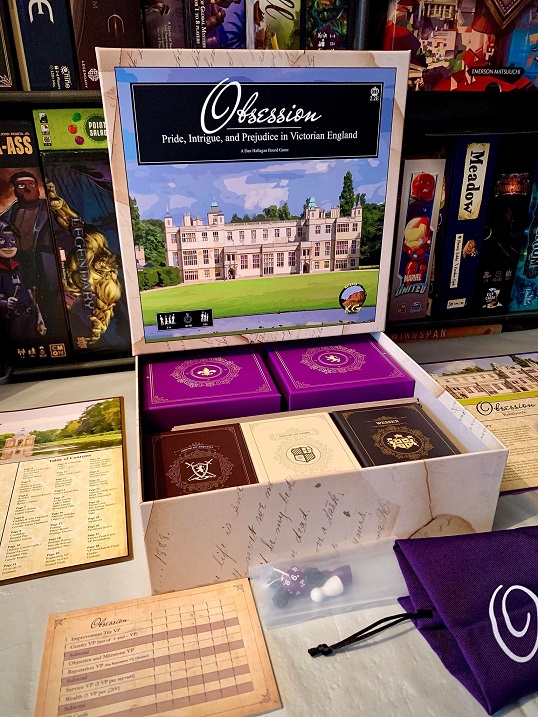
Genre: deck-building, worker-placement
Playing time: 30-120 minutes
Players: 1-4 (up to 6 with expansions), best at 2
Complexity: medium
Theme and Narrative
The Story
You’re a head of a once-great noble family in Derbyshire. But your glory days are well behind you, as you’re struggling to pay the bills and your mansion falls into disrepair.
After a long period of financial and other insecurities, your family’s prospects have finally begun to improve. You can now afford to start overhauling your decaying mansion with more attractive rooms and venues, as well as hiring staff.
You’ll then be able to attract casual and prestige guests, which will further boost your reputation, financial state, and acquaintances. All this to make an impression on the desirable Fairchild siblings from the Alderly Hall, a fancy villa down the road.
But to become the most renowned family in Derbyshire (=to accumulate the most victory points), you’ll have to do well in all of the above aspects.
The Game
Obsession is a highly thematic board game, where you can feel the above narrative at all times during the game. This is strongly driven by the social activities concept. Every turn, you’ll host a highly thematic event, requiring specific venues, guests, and staff.
You can invite a lady and a gentleman on a morning horse ride, two elderly ladies on a tennis match (this one particularly amused me when I played it), or a bunch of gentlemen to hold a political debate, for example. Who you invite, their backgrounds, and the favors they provide, will help build a story.
All the tiny details – the pictures and the flavor text, for example – encourage you to role-play your activities and guests (“Our daughter is having a romantic afternoon tea with lofty Mr. Fairchild”). This creates a strong narrative throughout the game, as well as many interesting and funny moments.
The only small part where the gameplay disconnects from the story was that the end result is not focused on whether your courtships with the Fairchilds are successful, but it’s just the sum of all the points. Yes, the courtships do matter and can yield a lot of points, but the rulebook makes the Fairchilds and the possibility of marrying one of them much more important than what it actually turns out to be.
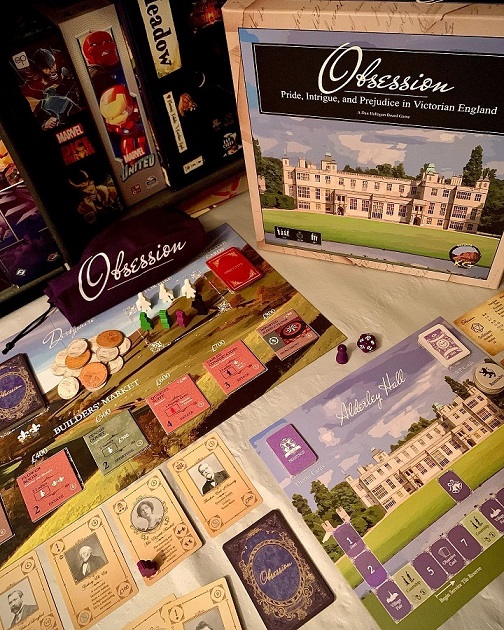
Artwork and Graphical Design
Another form the game stands out from the crowd is by its looks. There is very little artwork or illustrations as you are used to in other games. Obsession looks less “playful”. The graphical design, along with stock photos from 19th-century people is more up-tight, and as such, very appropriate for the era
The overall impression of the game is “elegantly stunning” and consistent across all the components. I love the gentry photos, as they bring the characters to life, I love the overall card design (and their playful flavor text), beautifully ornated crests, and rulebook pages.
Components
The component quality rounds up the authentic 19th-century experience. They are of high quality (the cardboard coins are especially enjoyable to handle, for example) and predominantly made from wood and cardboard.
The outstanding feature here is the staff meeples, each distinctly shaped and colored. They look and feel great and could only be improved if they were screen printed. Luckily, there’s an aftermarket for this and you can buy various lovely stickers and apply them on the meeples. But even “naked”, they are a joy to play with.
Another great touch is the cardboard storage boxes: two larger for game components and six smaller for each of the families (including those from expansions). Not only are they absolutely stunning, but they are also functional. The boxes hold all of the components in the base game box, including the expansions. Moreover, they fit in the box in a rather satisfying way, filling it out almost completely.
This storage solution is miles above plastic inserts (although plastic is more malleable, resulting in several smaller compartments – check Ark Nova, for example), let alone plastic bags. Although I did have to fetch a few of those from another game to store the various decks of cards. Yes, they fit into the cardboard boxes, but there are no binders and they are free to scatter and mix with other decks and components.
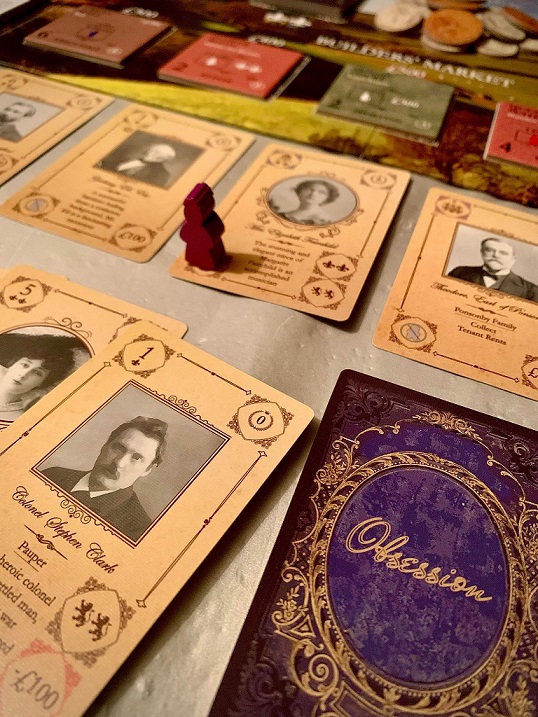
Learning Process and Rulebook(s)
Obsession is a result of a lot of love from one man (as if … he became obsessed with it) and nowhere does it show better than in the rulebook and the added glossary. Mr. Hallagan does have a bit of writing experience and he put it to good use here.
Long rulebook …
Even though the game is relatively simple to play, learn and teach (as you can read in the next chapter), both handbooks liberally take a combined 44 pages. The main rulebook is 16 pages long, which is already too thick for a game of this complexity – I reckon it could be cut in half without losing any clarity at all.
Everything is explained in detail several times over, and then in even more detail with regards to the thematic background. And then once more in the glossary. For example, when explaining how to buy a new activity tile, the rulebook already burdens you with details on which tiles are available and their peculiarities, which is probably not what you’re looking for when learning the game. It could have easily been in a separate chapter, if not even in a tile-by-tile appendix.
… but still a good read
But even though the rulebooks are too long, they are informative, interesting to read and explain the setting and thematic background exceptionally well. The writing is thorough, the tone playful, and the writing style leans towards vintage, although not that much that it would hamper comprehension. In other words, it will feel like you’re reading a Jane Austen novel. And you’ll be able to read it smoothly and you’ll understand everything it says.
Ideally, I would prefer a bit more editing in this area. Possibly a thinner main rulebook, perhaps slightly more technical, and the explanations, exceptions, and thematic stuff all moved to the glossary. But this is a minor grudge as the game is perfectly learnable as it is, you just need a bit more time to read it all through – luckily, the reader won’t be bored.
Setting up a game of Obsession
The provided cardboard boxes come in very handy during the setup. You should sort the components so that every house has its own box and just hand out one to each player. Common board components (the decks, staff, etc.) are also ready in minutes.
It’s worth mentioning the setup is somewhat customizable. The activity tiles you include or don’t include help mitigate some of the luck dependence and you could also remove undesired cards from the decks. There’s also an extended play, a longer variant, consisting of more turns, which turned out to be my preferred method of play.
Each of the four families (six, if you count the expansions) the players can choose from has a minor starting advantage. One might get an extra staff member, an extra family member, a bit more money to start with, and so on. While these don’t have a massive impact on the gameplay, it’s a nice touch and it helps to differentiate the families, thus bringing them more to life.
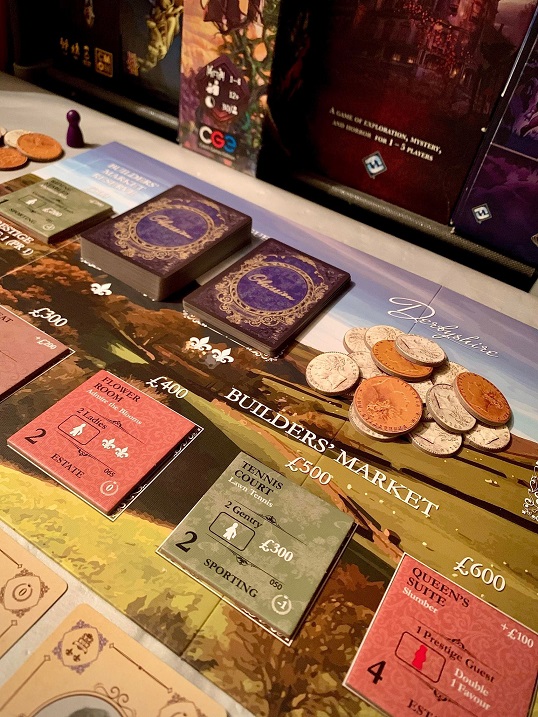
How to Play Obsession
One Turn
A typical turn of Obsession is relatively simple. You pick an activity from your tableau and you assign guests from your hand (gentry) to attend it. You also need appropriate staff (pictured on the activity tile and gentry cards) who make sure everything goes smoothly.
After that, you take the corresponding awards from the activity and participating guests: drawing more guests, increasing reputation, or gaining money are the main rewards. You finish your turn by shopping for more activity tiles.
The Theme of the Season
At a beginning of the season, a theme card for the courtship is drawn. This card determines what the Fairchilds are particularly interested in this season. Every few turns, when a season ends, there’s a courtship event.
That’s when the players compare this selected category of their mansion improvements with each other. The highest score receives victory point rewards, as well as a visit from one of the Fairchild siblings, who acts as a highly prestigious guest for the next season.
This is basically how the game runs. The theme cards set the tone for how to develop your mansion. You then use this in combination with available activities to try to host the most prestigious events. Just buying a tile usually isn’t enough – only when an activity is hosted, the tile is flipped to score more points.
Guests and Activites
Activities also require careful planning, especially those late-game larger events, that allow you to invite more guests. The more prestigious events and guests require special staff, so you must also plan to have that staff refreshed for that turn (normally, you can use each staff member every second turn).
When it comes to guests, you must also make sure they are in your reputation range (a track that is also used as a wild currency). Finally, their favors come into play. What will they bring to the table? Money is always nice, as you want to buy new event tiles every turn, but reputation and more guests are equally important. If you want to take your used guests back into your hand, you must pass an entire turn, which makes an influx of new guests particularly important.
As you can see, behind a simple concept, there are many factors you must consider while playing Obsession and it all blends into a tasty mixture of crunchy decisions.
Gameplay Impressions
Obsession provides smooth and fast gameplay, most of the time. Yes, there will be times when you will have many factors to consider (by this I mainly mean which guests you’ll invite) and your event planning will take a while. But normally, everything runs smoothly and you can usually plan your events during other players’ turns.
The game offers many interesting and thematic choices. For example, one of the initial choices is whether you should host a Village Fair planning event. On one hand, every future fair will bring in extra cash and reputation, but on the other, the Fairchilds are not too keen on you mingling with the commoners, and you lose some of the victory points because of that. If that is the theme of the courtship, then you’re in trouble …
Delightful pay-offs and randomness of the card draw
Having planned a successful event, you are rewarded with favors, which is an especially satisfying part of the game. All your hard work is paid off now and the excitement of drawing new gentry cards or buying new tiles never wears off. You never know who will be your next guest …
The guests can vary in quality and usability quite a lot. And I’m talking from guests from the same deck, not regular vs. prestigious guests. While one turn you might draw a solid guest worth a victory point or two and also someone you can use, there will be times, when you’ll draw nothing but guests with negative victory points (yes, those are a thing).
Or, if we talk about prestigious guests, you might draw ones that are out of your reputation range or ones you don’t have staff for. This means you can’t invite your valuable guest to any of the events. At least they aren’t worth victory points, I guess.
A similar thing can be said about objective cards, especially those that require you to build a particular tile. What good are they to you, if that tile never comes out of the bag the entire game (which can easily happen)?
But as the author said himself – this is by design. Obsession is about a thematic experience, not competitive play. Luck is supposed to portray the unexpected events of the era.
Upswings, downswings
But I argue that this makes the game contradict itself a bit. On one hand, it rewards careful planning, on the other hand, everything you planned can be thrown out of the window, if you’re unlucky with the draw (or other players are lucky). What good are all those Valets you hired to help you with your male guests if all you draw are ladies?
So, yes, luck does play a role in Obsession and if you’re not comfortable with that, you should think twice. Although it can be frustrating to lose a game you played for an hour or two by a couple of points, knowing clearly that you would have won if you were lucky at just one card draw, I actually didn’t find this to be such a major problem. You need to approach the game thematically, not mechanically.
Obsession is a swingy game and luck can go both ways. If you can’t handle the downs, you don’t deserve to enjoy the ups. Ride the wave, immerse in the narrative it creates, and have fun. The swings actually help to keep the atmosphere casual – there’s always something interesting going on and the best player won’t always win. This makes the game very suitable for couples where the male is a gamer, and the woman is a more casual player. The theme will be perfect for her.
Top 12 Board Games For Couples
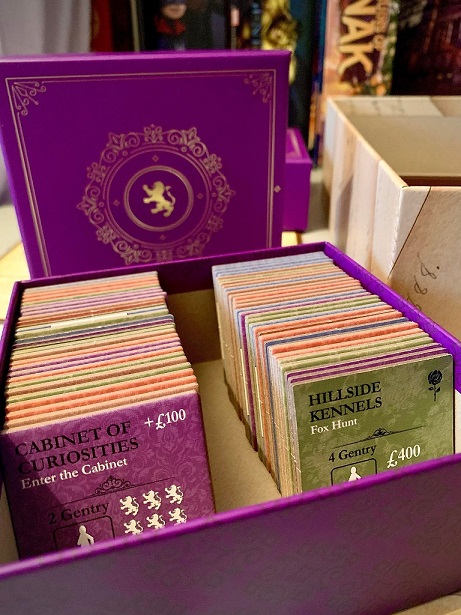
Replay value and long-term appeal
Although the games play similarly to one another, a high variety of cards and tiles helps a lot with the replay value as it’s the main differentiator between games. The luck/variance is another positive contributor here. It keeps the gameplay fresh, as there’s always some new combo appearing, which keeps you enthusiastic even after half a dozen plays.
The somewhat unique mixture of highly thematic mechanics, requiring careful planning and interrupted by capricious swings creates a game experience paralleled by very few games (perhaps Robinson Crusoe would be a good analogy). And I argue this uniqueness is what is the main long-term appeal of Obsession and what will keep it in your collection.
Player vs. player interactivity
Albeit there are ways to mess with other players (stealing staff and reputation), most of the interaction is indirect, in particular, it’s about sniping a certain tile from the market. Or competing for courtships. That’s as far as it goes, you’re mainly minding your own board and things you do and will do in the future.
Scalability and playing time
Obsession plays well at all player numbers, although the higher player counts don’t add much gameplay value because of the low PvP interactivity. They do increase the playing time – a 4 player game can easily last two or more hours.
Two seems to be the perfect number of players and, as already mentioned, Obsession is particularly great for couples, since it has such a women-friendly theme. This is also the number that will benefit the most from the extended play variant (more turns and more chances to develop your villa mean more time to immerse in the narrative).
Playing Obsession Solo
Besides multiplayer, Obsession offers a fully-fledged solo experience, as well. The rules are largely the same and you play against an AI opponent. The maintenance of the bot couldn’t be simpler. It’s represented by a card, depicting how many points each of his categories count for in courtship.
For that reason, the theme of the season is drawn later, just before courtship. This means you have to alter your strategy a bit to take that into account (and to try to make some educated guesses), but it’s nonetheless equally challenging and fun to play.
The bot also helps by removing tiles from the display, helping you to see more of them, but also keeping you under pressure by threatening to take away what you need. One last thing it does is have an end-game target score for you to beat. If the bot beats you at courtships, this target can increase. Oh, and there are several bot cards available, differentiating in difficulty and play style.
So, the solo mode works great mechanically, the bot requires minimum maintenance, resulting in smooth gameplay. The high variance remains a problem and I also felt it was harder to immerse in the theme by myself. But that probably says more about me than the game.
But still, I had a lot of fun playing alone. I give the solo mode a thumbs up and you can consider it even for strictly solo play. Just don’t be too hung up on whether you win or lose.
6 Reasons We Play Board Games Solo – And Why You Should Too
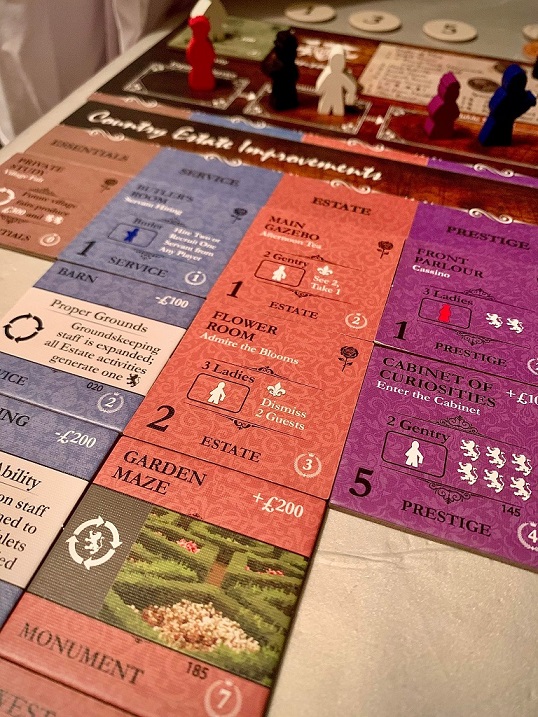
Obsession Expansions: Wessex and Upstairs, Downstairs
Two expansions have been published so far, as well as promotional tile packs.
The first expansion, Wessex, is pretty straightforward. It adds one new family, as well as several new gentry cards. Another nice addition is solitaire opponents for extended play. Gameplay-wise, it doesn’t change anything, so you can add the Wessex expansion right away.
Upstairs, Downstairs
The second expansion, Upstairs, Downstairs, is a substantially larger addition. Let’s have a look at its features first:
- Sixth family, the Howards, also with components for the fifth and sixth players (don’t ask me how that plays, because I have no desire to play Obsession with that many players).
- Four new optional staff members, that you can add to activities or guests. The cook can help you mitigate the reputation limit, the hall boy provides extra cash, the head housemaid allows you to screen guests (take two and pick one), and the useful man has several abilities.
- New game modes: solo estate challenge, team play, tableau obsession – all designed with reduced randomness in mind.
- New objective and milestone cards.
- Extra activity tile and guests, including promotional.
News staff members
If you’re looking to enhance Obsession, Upstairs, Downstairs is the expansion to get. The new staff is great. They give you much more flexibility. The cook allows you to host big events and guests right from the start, helping you to get your game going.
Head housemaid with its screening ability is perhaps the most useful of all. It helps mitigate one of the main issues from the base game – random guest draw. It’s not almighty, as you can use it only once every two turns, but generally speaking, it helps to avoid those negative point guests quite successfully. Yes, luck still plays a role, but at least you feel you have some control over it.
The hall boy and the useful man are mostly good for their money-making or money-saving abilities. Overall, you’ll have more money in the U/D expansion, allowing you more freedom when buying new tiles.
Other rule changes
The new milestone cards are also a way to help deal with the luck from the base game – this time with objective cards. They are an alternative to them and are common goals that you get points for if you’re the first (or second) to complete them. While not as fun as personal objective cards, they are a lot less random.
The rules of the expansions themselves are not too different from the base game. You need to learn what the new staff does (player aid cards are included) and there’s an update on how the passing works. Now you can also hire staff during your pass turn, which washes away the sour taste from the base game where you had to spend an entire separate turn to do that.
Unfortunately, the rulebook somewhat overcomplicates what the expansion adds, as it’s intimidatingly long and poorly structured.
The new game modes are also designed with eliminating the luck element in mind. Although I haven’t had the need to thoroughly test them all, they do look promising and they increase the long-term appeal of the game, particularly for the solo player. There are several variants included and you can further customize the setup, as already previously mentioned.
More of everything
The general impression of the Upstairs, Downstairs expansion is more of everything. And I don’t mean just the components, but also the gameplay. You’ll have more options and more flexibility. Generally, more resources will mean you can host better events and invite better guests, making their favors a lot more enjoyable. It’s always nicer to reap rewards from 6 guests rather than 2.
As a result, the end-game scores are almost doubled compared to the base game. Of course, the playing time is also slightly increased, as is the crunchiness of your decisions (try selecting guests and allocating staff to a 6-guest event optimally). Players’ turns will be longer as a result, especially toward the end of the game.
Upstairs, Downstairs is a great expansion. It helps mitigate some of the shortcomings of the base game (luck and the boring staff hire turn) while adding a lot of interesting decisions and options to the player’s repertoire.
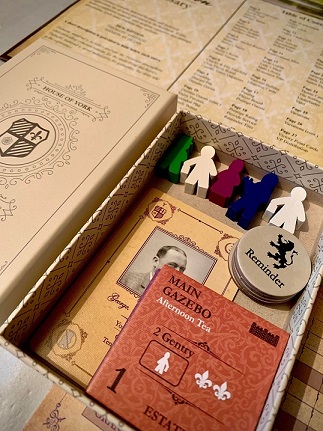
Promotional stuff
Finally, there are the promotional gentry cards and event tiles (some included in the expansions, some available separately). You need to be mindful of adding those to the game, as some of them are relatively unbalanced and a bit weird, to be frank. Moreover, they increase the overall variance of the game (which is high as it is).
On the other hand, they are interesting, and that weirdness might just be what your game needs to go from good to great.
Conclusion
My main impression of Obsession is that it’s truly an artwork of love. Dan Hallagan poured all he had into it and it truly shows throughout the game, whether you play the base game or add the expansions. I can recommend it to pretty much everyone, from casual gamers to hardcore gamers.
Even if you are right now not too keen on the theme and setting, it will crawl under your skin and you will appreciate it. But if you’re already in love with the Victorian theme, you’ll absolutely adore the game!
In the end, the luck factor did not pose such a large concern for me as I expected. Even if the draw messed up my strategy, I could always see the humor side of it and was entertained by how the events panned out. I’d say that unless you absolutely can’t stand any randomness in your games, you’ll be fine in Obsession.
Now, do I recommend buying the expansions? This one’s a bit more tricky. Definitely not from the get-go. Obsession offers plenty of gameplay in its core box and the price of all the boxes can get high. But then again, particularly the Upstairs, Downstairs expansion hits the nail exactly on its head and you’ll want to add it at some point anyway.
To answer my question from the intro – yes, Obsession does live up to the hype. It’s a fantastic board gaming experience.
For European buyers, Obsession is available on Philibertnet, while Americans can buy it directly from Kayenta.
Do you like what you just read? Consider subscribing for more content:

